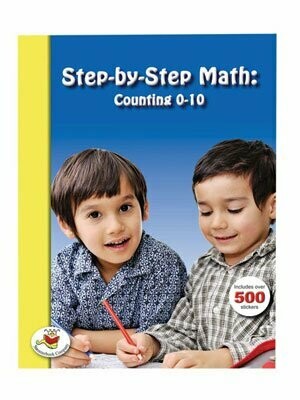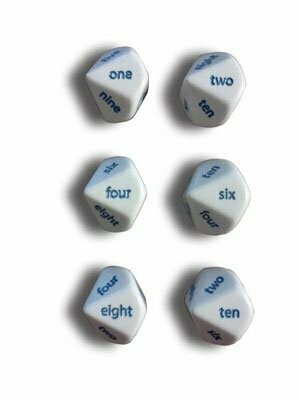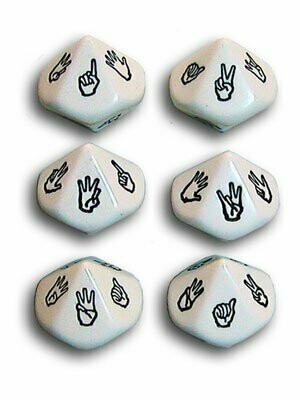1-10 Dice
A ten-sided die with the numerals 1, 2, 3, 4, 5, 6, 7, 8, 9, 10.
Ideas for Use
Easy Class Review--Substitute for Flash Card Drill
Divide the class into groups. Give each group a pair of numbered dice. Have them roll the dice and practice one of the operations as many times as possible until time is called. This can be made harder or easier by the dice selected.
Game Board Upgrade
Dice needed: 2 numbered dice
Other equipment: game board and movers
1. Decide whether the dice will be added, subtracted, multiplied, or divided.
2. Roll the dice and state the correct problem and answer. Then move the number shown on the die with the lower value.
3. If the problem or answer is incorrect, the turn is forfeited.
4. Other rules may apply depending on the board game used.
Example: A red and a blue dice are rolled. The red die is the movement die. Roll: 3(r), 5(b)
Addition: Say "3+5=8" or "5+3=8" and move 3.
Subtraction: Say "5-3=2" or "8-3=5" and move 3.
Multiplication: Say "3x5=15" or "5x3=15" and move 3.
Division: Say "15÷3=5" or "15÷5=3" or "5÷3=1 with a remainder of 2" and move 3.
Game Board Upgrade - alternate
Dice needed: 3 or more numbered dice
Play as above, except roll all the dice and add them all.
To Twenty
Dice needed: 1 number die
1 two-function die for addition and subtraction
Other equipment: pencil and paper for score keeping
1. Roll both dice to determine the starting number.
2. Roll the dice again and add or subtract as indicated.
3. After each roll, give a point to the person who correctly announces the new total first.
4. The first person to get to twenty wins.
Note: This game will occasionally produce negative numbers.
To Twenty - alternate
Dice needed: 2 numbered dice
Other equipment: pencil and paper for score keeping
1. Determine which operation will be used for the game.
2. Roll both dice.
3. Give a point to the person who correctly answers first.
Probability
Since the different shapes of dice have different numbers of sides, they are perfect for setting up and solving probability problems.
Use various combinations of dice to make easier or harder math drills.
  |
Binary Dice and 1 to 2 Dice | This combination is good for those just learning to add. The combination is also useful for beginning probability or any other time a very small number of combinations is desired. |
|
  |
0 to 5 Dice | addition - limits problems to ten. All problems rolled can be reproduced on fingers using one hand for each die. subtraction - limits problems to 5 − 5 multiplication - limits problems to 5 × 5 making it easy to illustrate the problems rolled with physical objects or by drawing shapes on paper |
|
  |
0 to 9 Dice and Binary Dice | addition - provides practice with + 0 and + 1 families subtraction - provides practice with − 0 and − 1 families multiplication - provides practice with × 0 and × 1 families |
|
  |
0 to 9 Dice and 1 to 2 Dice | addition - provides practice with + 1 and + 2 families subtraction - provides practice with − 1 and − 2 families multiplication - provides practice with × 1 and × 2 families |
|
  |
0 to 9 Dice and 1 to 3 Dice | addition - provides practice with + 1, + 2 and + 3 families subtraction - provides practice with − 1, − 2 and − 3 families multiplication - provides practice with × 1, × 2 and × 3 families |
|
  |
0 to 9 Dice and 0 to 5 Dice | addition - provides practice with + 0 to + 5 families subtraction - provides practice with − 1 through − 5 families multiplication - provides practice with × 0 to × 5 families |
|
  |
0 to 9 Dice | addition - provides practice with all one hundred basic facts from 0 × 0 through 9 × 9 multiplication - provides practice with all one hundred basic facts from 0 × 0 through 9 × 9 |
|
  |
1 to 10 Dice | This set provides addition and multiplication practice through the tens. Subtraction may be practiced through 10 − 10. |
|
  |
1 to 12 Dice and 0 to 9 Dice | This set offers good subtraction practice. Multiplication problems are limited to 12 × 9 which is good when first introducing the ten, eleven and twelve families. |
|
  |
1 to 12 Dice | This set provides addition and multiplication practice through the twelves. Subtraction may be practiced through 12 − 12. |
|
  |
1 to 20 Dice and 0 to 9 Dice | This set offers subtraction practice with greater differences than other combinations. | |
  |
1 to 20 Dice | This set is great for students who benefit from tougher mental math challenges. |







